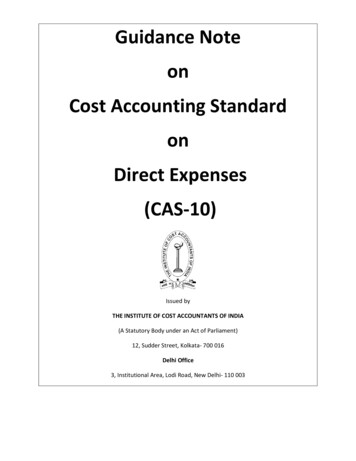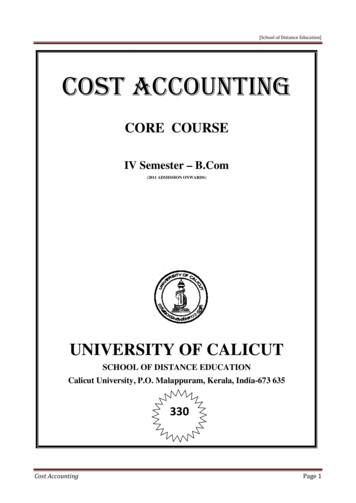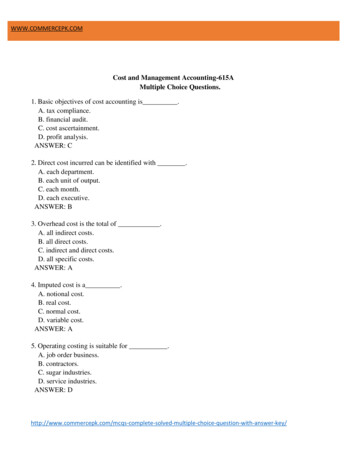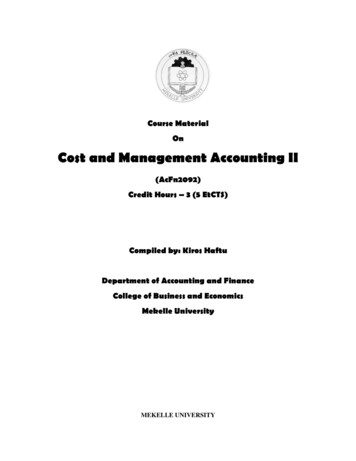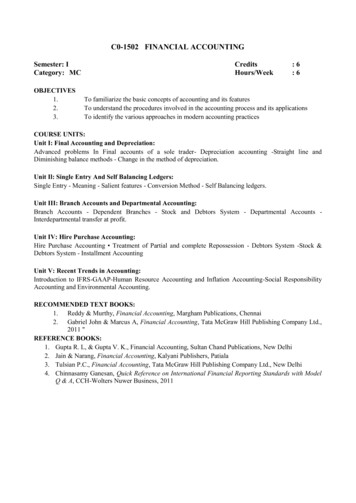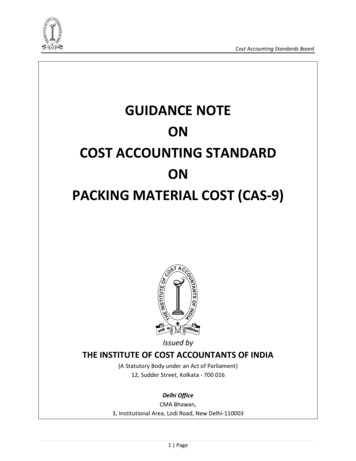
Transcription
Cost Accounting Standards BoardGUIDANCE NOTEONCOST ACCOUNTING STANDARDONPACKING MATERIAL COST (CAS-9)Issued byTHE INSTITUTE OF COST ACCOUNTANTS OF INDIA(A Statutory Body under an Act of Parliament)12, Sudder Street, Kolkata - 700 016Delhi OfficeCMA Bhawan,3, Institutional Area, Lodi Road, New Delhi-1100031 Page
Cost Accounting Standards BoardList of ion62Definitions93Principles of Measurement114Assignment of nnexurePageIIIIIIIVType of Packing Materials UsedDetails of packing materials used in different industriesIllustration of Presentation of Packing MaterialCost Accounting Standard on Packing Material Cost293132332 Page
Cost Accounting Standards BoardFOREWORDThe Council of the Institute of Cost Accountants of India in its meetingheld on 21st July 2012 has approved the release of the Guidance Noteon Cost Accounting Standard on Packing Material Cost (CAS-9) asrecommended by the CASB. I am happy to note that the CASB hasbeen making consistent strides and is coming out with series ofpublications relevant for the members of the profession.The Guidance Note on Packing Material Cost is a part of that series and has come out atthe appropriate time.The Guidance Note lists out Details of Packing Materials used in different Industries andtheir presentation for the purpose of costing. I hope that members and otherstakeholders would find the Guidance Note helpful.I wish to place on record my hearty appreciation to Shri Rakesh Singh, Vice Presidentand Chairman, CASB and all the members of the CASB for bringing out this guidingliterature for the members. The CASB in 2011-12 has made a considerable progress andI am very much hopeful that it will continue to do the good work for the profession.(M GOPALAKRISHNAN)PresidentDate: 21st July 20123 Page
Cost Accounting Standards BoardPREFACEI am pleased to present the Guidance Note on the Cost AccountingStandard on Packing Material Cost (CAS-9). This Standard dealswith the Principles and Methods of classification, measurementand assignment of packing material cost for determination of thecost of product and the presentation and disclosure in the coststatement.I am extremely grateful to Shri A. Om Prakash, Shri Murali Ganesan, Members of theBoard for their valuable efforts in finalisation of this Guidance Note.I am also thankful to all the members of the Cost Accounting Standards Board of theInstitute for their valuable contribution in finalisation of the Guidance Note.I am thankful to Shri M Gopalakrishnan, President of the Institute for his vision,guidance and support that I have received in carrying out the activities as Chairman ofthe Cost Accounting Standards Board.I would also like to place on record the efforts put in by the CASB Secretariat, headed byShri JP Singh, Director (Technical) and the support provided by Shri ML Mehta (Advisor),for timely completion of this document.I am confident that this Guidance Note would be well received by the members.(RAKESH SINGH)Vice President and Chairman, CASBDate: 21st July 20124 Page
Cost Accounting Standards BoardGuidance Note onCost Accounting Standard on Packing Material Cost (CAS-9)The Council of the Institute of Cost Accountants of India has issued the Cost AccountingStandard on Packing Material Cost (CAS - 9) which lays down a set of principles and methods ofclassification, measurement and assignment of packing material cost for determination of thecost of product and the presentation and disclosure in the cost statement.The Guidance Note deals with principles and methods as provided in the CAS-9 and practicalaspects in connection with the determination of packing material cost of a product.In the preparation of cost statement and its attestation if any packing material cost is required,the same shall be determined with reference to CAS-9.Further The Companies (Cost Accounting Records) Rules, 2011 provides that every company,including a foreign company defined under section 591 of the Companies Act, 1956 which isengaged in production, processing, manufacturing or mining activities have to maintain costaccounting records in accordance with the generally accepted cost accounting principles andcost accounting standards issued by the Institute, to the extent these are found to be relevantand applicable. The above Rules further provides that these will be applicable to companieswherein aggregate value of net worth as on the last date of the immediately preceding financialyear exceeds five crores of rupees; or wherein the aggregate value of the turnover made by thecompany from sale or supply of all products or activities during the immediately precedingfinancial year exceeds twenty crores of rupees; or wherein the company’s equity or debtsecurities are listed or are in the process of listing on any stock exchange whether in India oroutside India.The Companies (Cost Audit Report) Rules 2011 cast a duty on a Cost Auditor appointed underSection 233B of the Companies Act 1956 to certify inter alia that books and records maintainedby the company are in conformity with the Cost Accounting Standards issued by the Institute tothe extent these are found to be relevant and applicable.The Cost Accounting Standards have been set in bold italic type. Numbering of standard hasbeen retained as in CAS-9 for facility of reference.5 Page
Cost Accounting Standards BoardChapter 1IntroductionPackaging is enclosing or protecting products for distribution, storage, sale, and use. Materialused for packaging is termed as Packing Material.Packing material is required for containment, protection, handling, presentation, delivery,transporting, warehousing, logistics, sale, and end use of the product as detailed below: Physical protection - The products enclosed in the package require protection from,among other things, shock, vibration, compression, temperature, and the like. Barrier protection - A barrier from oxygen, water vapour, dust, and the like, is oftenrequired. PackingKeeps the contents clean, fresh, sterile and safe for theintended shelf life Containment or agglomeration - Small objects are typically grouped together in onepackage for reasons of efficiency. For example, a single box of 1000 pencils requires lessphysical handling than 1000 single pencils. Liquids, powders, and granularmaterials need containment. Information transmission - Packages and labels communicate how to use,transport, recycle or dispose of the package or product. With pharmaceuticals,food, medical and chemical products, some types of information are required byregulatory authorities. Some packages and labels are used for track and trace purposes. Marketing - The packaging and labels are used by marketers to encourage potentialbuyers to purchase the product. Security - Packaging can play an important role in reducing the security risks ofshipment. Packages can be made with improved tamper resistance to deter tampering. Convenience - Packages can have features that add convenience in distribution,handling, stacking, display, sale, opening, reclosing, use, dispensing and reuse. Portion control - Single serving or single dosage packaging has a precise amount ofcontents to control usage. Bulk commodities (such as salt) can be divided into packagesthat are more suitable for individual households. It also aids the control of inventory,selling sealed one-litre-bottles of milk, rather than people bringing their own bottles.Type of packing material required depends on the type of product to be packed. Packingmaterials are of various types. Type of packing material required for a product depend uponthe nature of the product to be packed. Illustrative list of packing material used is at Annexure6 Page
Cost Accounting Standards BoardI. It varies from industry to industry as items to be packed will be different as indicated inAnnexure II.Packing Material is classified under a common designation on the basis of similarities of nature,attribute, source of supply and the like. For example Wooden crates, Aluminium foil, paper bag,gunny bags, HDPE bags, Glass, plastic bottles, closures (metal / plastic rubber) and the like.On the basis of source of supply, packing materials are classified as indigenous materials /imported materials. Indigenous packing materials are manufactured within the country andimported packing materials are purchased from other countries.For the purpose of this standard Packing Materials are classified into primary and secondarypacking materials.Primary Packing Material are for holding the product, keeping the contents clean, fresh, sterileand safe for the intended shelf life and sale. Primary packing material required for a productwill depend upon the type of the product to be packed.For example for pharmaceutical industry primary packing material will be insertion related toproduct, Blister strips for tablets / capsules, bottle, tubes and the like. For confectionary / foodproducts, it may be butter paper, wrappers, box, tray, can, jar and so on.Primary packing material may also be intended for shop display .But the function of primarypacking material is essentially for holding a product. Depending upon use, the same materialmay be classified as secondary packing material. For example, a shrink wrap can be primarypackaging when applied directly to the product, and secondary packaging when combiningsmaller packages.Primary packing material cost is part of production cost of a cost object. In case two types ofprimary packing materials are used viz. plain and fancy, the difference in the plain and fancypacking material is to be treated as secondary packing. In such cases, differentiating betweenprimary and secondary packaging will depend upon the specific facts and circumstances of aproduct to be packed and type of industry.Secondary packing material is the term used to describe larger cases or boxes that are used togroup quantities of primary packaged goods for distribution.7 Page
Cost Accounting Standards BoardSecondary Packing material also include transit packaging such as wooden pallets, board andplastic wrapping and containers that are used to collate the groups into larger loads fortransport, which facilitates loading and unloading of goods.Some products such as sugar, fertilizers, cements, and the like are sold in bags and do not needany further packing. Such packing is to be treated as primary packing and will form part of costof production.8 Page
Cost Accounting Standards BoardChapter 2Definitions4.1 Abnormal cost: An unusual or atypical cost whose occurrence is usually irregular andunexpected and / or due to some abnormal situation of the production or operation.4.2 Administrative Overheads: Cost of all activities relating to general management andadministration of an organisation.4.3 Cost Object: This includes a product, service, cost centre, activity, sub-activity, project,contract, customer or distribution channel or any other unit in relation to which costs areascertained.4.4 Direct Employee Cost: The cost of employees which can be attributed to a Cost Object inan economically feasible way.4.5 Direct Expenses: Expenses relating to manufacture of a product or rendering a service,which can be identified or linked with the cost object other than direct material or directemployee cost.4.6 Direct Materials: Materials the costs of which can be attributed to a cost object.4.7 Distribution Overheads: Distribution overheads, also known as Distribution Cost, are thecosts incurred in handling a product from the time it is ready for despatch until it reaches theultimate consumer.4.8 Finance Costs: Costs incurred by an enterprise in connection with the borrowing of funds.4.9 Imputed Costs: Hypothetical or notional costs, not involving cash outlay, computed forany purpose.4.10 Marketing overheads: Marketing Overheads comprises selling overheads anddistribution overheads.4.11 Packing Materials: Materials used to hold, identify, describe, store, protect, display,transport, promote and make the product marketable and communicate with the consumer.9 Page
Cost Accounting Standards Board4.11.1 Defectives: Packing materials that do not meet quality standards. This may includereworks or rejects.4.11.1.1 Reworks: Defectives which can be brought up to the standards by putting inadditional resources.4.11.1.2 Rejects: Defectives which cannot meet the quality standards even after puttingin additional resources.4.11.2 Packing Material Cost: The cost of material of any nature used for the purpose ofpacking of a product.4.11.3 Primary Packing Material: Packing material which is essential to hold the productand bring it to a condition in which it can be used by or sold to a customer.4.11.4 Reusable Packing Material: Packing materials that are used more than once to packthe product.4.11.5 Scrap: Discarded packing material having some value in a few cases and which isusually either disposed of without further treatment or reintroduced into the productionof packing material.4.11.6 Secondary Packing Material: Packing material that enables to store, transport,inform the customer, promote and otherwise make the product marketable.4.12 Packing Material Development Cost: Cost of evaluation of packing material such as pilottest, field test, consumer research, feedback, and final evaluation cost.4.13 Production overheads: Indirect costs involved in the production process or in renderingservice.4.14 Selling Overheads: Selling Overheads, also known as Selling Costs, are the expensesrelated to sale of products and include all Indirect Expenses in sales management for theorganization.4.15 Standard Cost: A predetermined cost of resource inputs for the cost object computedwith reference to set of technical specifications and efficient operating conditions.10 Page
Cost Accounting Standards BoardChapter 3Principles of Measurement5.1. Principle of valuation of receipt of packing material:5.1.1 The packing material receipts should be valued at purchase price including duties andtaxes, freight inwards, insurance, and other expenditure directly attributable to procurement(net of trade discounts, rebates, taxes and duties refundable or to be credited) that can bequantified at the time of acquisition.The valuation of receipt of packing materials is to be based on the terms and conditions statedin the purchase /supply order. It indicates the source of supply i.e. indigenous or imported andthe like.Purchase of indigenous Packing material:The purchase / supply order inter alia states:(1) Specification of packing material being purchased(2) Purchase price(3) Quantity of supply(4) Time of supply(5) Place of supply(6) Payment terms(7) Other commercial conditions regarding inspection, rejection, cash / trade discount etc.In addition to basic purchase price, duties and taxes, freight inwards, insurance and otherexpenditure directly attributable to procurement are to be taken into account while valuing thereceipt of packing material if these can be quantified with reasonable accuracy at the time ofreceipt. If any of these items of expenditure cannot be quantified with reasonable accuracy,these are treated as material handling cost, an item of overhead.Trade / cash discount, rebates, taxes and duties refundable (or to be credited by the taxingauthorities) are to be set off. Examples of taxes and duties to be deducted from cost areCENVAT credits, credit for countervailing customs duty, sales tax set off / vat credits and othersimilar items of credit recovered / recoverable.Imported Packing Material:Packing Materials are imported from other countries depending upon the availability in thecountry / economics of import. Import license may be required in certain cases. Terms of11 Page
Cost Accounting Standards BoardPurchase inter alia may be FOB, CIF port/airport. FOB (Free on Board) means that goods areloaded on the ship and there is no additional charge relating to loading and the like. Purchaserhas to pay transit insurance and freight from place of loading to its destination. In case of CIF(Cost, Insurance & Freight) price, price includes besides basic price, transit insurance andfreight. On receipt of packing material, bill of entry is prepared and other custom formalitiesare complied with for clearance of the goods.Following points are to be considered while valuing imported packing material:a. Actual customs duty paid on the basis of classification by the customs authorities will beassigned, net of any credits. Higher duty paid under protest will not be included in costif there is reasonable expectation that the entity will satisfy the conditions for theexcess duty to be refunded.b. Packing Material imported free of duty or at concessional rate of duty under exportincentive scheme will be accounted for at the actual rate of duty applicable so long asthere is reasonable expectation that the entity will satisfy the conditions for the dutyexemption or concession. In case the packing material is used other than the intendedpurpose, provision for import duty / penalty leviable, if any, shall be provided. This entrymay be offset when the material is available for export purposes at the imported parityrate of material.c. Harbour dues, stevedoring charges, congestion charges, and the like on the basis ofactual, if imported singly. If the packing material is imported as part of a basket, then asuitable basis such as proportionate weight, volume or value will become the basis forassigning the above chargesd. If Intermediate storage is called by the nature of transport, the actual charges by thestorage provider will be included in the cost.For example transporting the material by different mode of transport due to certaintransport constraint.e. Commission Agent’s Charges will be added to cost of materials. Where other servicesare also provided by the commission agent besides procurement of orders, e.g.arranging for LC, the charges for such services will also be assigned to the materialscovered on a suitable basis.f. Adjustment of CENVAT / VAT as per applicable regulationg. Duty drawback and other similar duties subsequently recoverable shall also bededucted from the cost of materialh. Bank Charges are in the nature of borrowing cost or in the nature of administrativeoverheads will not form part of packing material cost.12 Page
Cost Accounting Standards BoardCost incurred for acquisition, inspection, storage, movement of materials and insurance is alsoto be assigned to packing material cost on rational basis.Handling costs upto works / factory gateIf handling cost is specific and handled singly, it is to be assigned to the packing materialhandled. If employees are used for handling the packing material, it is to be treated asprocurement overheads and not included in Packing Material Cost. In other cases wherehandling charges are included in the carrier’s responsibility, there will be no assignable cost dueto handling.Incoming InspectionIf the packing material calls for inspection by a third party, specific cost will be assigned to thepacking material inspected. If the inspection is carried out internally with own employees, it isto be treated as procurement overheads and not included in Packing Material Cost. If theinspection is part of the vendor’s responsibility, no separate inspection cost will be assigned.Other cost incurred for packing material acquisition is insuring of packing material. If insurancepremium is specific and insured singly, it is to be assigned to the specific packing materialinsured. In case it is part of a comprehensive policy then the assignment of the insurancepremium will be on the basis of the proportionate value insured. If insurance becomes part ofthe carrier’s responsibility no separate cost will be assigned in this regard.5.1.2 Finance costs directly incurred in connection with the acquisition of Packing Materialshall not form part of Packing Material Cost.Finance costs are interest and the like on borrowed funds. Finance costs are excluded frompacking material cost. The letters of credit charges are for credit risk or a transaction risk(demand bill) and / or part of bank charges, which form part of administrative overheads. Suchcharges are not finance charges except where they are in the nature of borrowing costs.Sometimes goods are kept in bonded warehouse and clearance of goods is delayed. This mayhappen due to any financial stringency delaying the payment to the bank. Such payments ofstorage are to be excluded from packing material cost and are dealt with in the financialaccounts.5.1.3 Self manufactured packing materials shall be valued including direct material cost,direct employee cost, direct expenses, job charges, factory overheads including share of13 Page
Cost Accounting Standards Boardadministrative overheads comprising factory management and administration and share ofresearch and development cost incurred for development and improvement of existingprocess or product.The packing material may be manufactured by an entity. It is to be valued taking into accountall the relevant cost incurred in manufacturing the packing material. For example it shall takeinto account the direct material cost, direct employee cost, direct expenses, share of factoryoverhead and share of administrative overheads relating to production.In case any packing material development cost such as pilot test, field test consumer research,feedback and final evaluation cost is incurred, it will form part of the cost of self manufacturedpacking material.Direct Material is the cost of material which can be attributed to a cost object. It is consumedfor production of a product or service which is identifiable in the product and forms directmaterial cost.Direct material consumed in the manufacture of packing material is to be valued at purchaseprice including duties and taxes, freight inwards, insurance and other expenditure (net of tradediscounts, rebate, taxes and duties refundable or to be credited) as detailed under paragraph5.1.1.Direct employee cost is that portion of wages and salaries which can be identified with andcharged to a cost object. Direct Employees engaged in the manufacturing of packing materialare to be identified. Remuneration paid to them and share of other employee related cost areto be determined as per Standard CAS-7 on Employee cost.Direct Expenses specifically identifiable with the production of packing material (for examplejob charges, hire charges for use of specific equipment, cost of special designing of packingmaterial or drawings etc.) shall form part of the cost of self manufactured packing material.Factory overheads comprise of indirect materials, indirect employee costs and indirectexpenses which are not directly identifiable or allocable to a cost object in an economicallyfeasible way. these are the indirect costs incurred in the production process or in renderingservice.The Factory overheads includes administration cost relating to production, factory ormanufacturing.14 Page
Cost Accounting Standards Board5.1.4 The valuation of captive consumption of packing materials shall be in accordance withparagraph 5 of Cost Accounting Standard 4.Para 5 of the Cost Accounting Standard on Cost of Production for Captive Consumption (CAS-4)deals with the determination of cost production for captive consumption. While valuing thecost for captive consumption of packing material, the following elements of costs are to beconsidered:I. Material consumed (indigenous, imported, bought out items, self manufactured items,process material etc.)II. Direct employee cost (as per CAS-7)III. Direct expenses (for example cost of utilities, royalty, technical know-how charges fordesign)IV. Quality control CostV. Research and DevelopmentVI. Share of factory overhead (including factory administration and managementexpenses)VII. Inputs received freeVIII. Adjustment for misc income, if any.5.1.5 Normal loss or spoilage of packing material prior to receipt in the factory shall beabsorbed in the cost of balance materials net of amounts recoverable from suppliers,insurers, carriers or recoveries from disposal.Sometimes packing materials are lost in transit or spoiled. Treatment of loss will depend uponthe terms and conditions of purchase order. If the purchase order does not specify any level ofloss, and supplier is responsible to supply good quantity, the loss is to be recovered fromsuppliers or insurers as the case may be.The normal loss is to be absorbed by the good units. Abnormal loss of packing material is takento reconciliation and does not form part of the packing material cost.5.1.6 The forex component of imported packing material cost shall be converted at the rateon the date of the transaction. Any subsequent change in the exchange rate till payment orotherwise shall not form part of the packing material cost.15 Page
Cost Accounting Standards BoardForex conversion has to be on the date of transaction. The cost and financial accounts will havethe same basis for alignment. The date on which the transaction first qualifies for recognition inaccounts is adopted as the date of transaction. The difference between the actual payment andthe amount taken as packing material cost is taken to a separate financial account as exchangerate variations not being part of the packing material cost. Foreign Exchange difference shall bea reconciliation item.5.1.7 Any demurrage, detention charges or penalty levied by the transport agency or anyauthority shall not form part of the cost of packing materials.Demurrage and penalties are levied by the transport agency or any other authority such ascustom authorities for delay in clearance of wagon/vessel and the like.Illustrations are: Demurrages levied by transporter for not removing goods, Penalties for keeping hazardous goods in unauthorized places in transit without propersafeguards. Penalties or interest levied by custom authorities for delayed clearance.Demurrage and penalties are abnormal cost and are not part of the packing material cost. It istaken to reconciliation.5.1.8 Any Subsidy / Grant / Incentive or any such payment received / receivable with respectto packing material shall be reduced for ascertainment of the cost to which such amounts arerelated.Subsidy and grant received should be recognized on a systematic basis. These should bematched with the related cost for which these are intended to compensate. Subsidy receivedfor any packing material is to be reduced from the packing material cost.Subsidy receivable for using specific packing materials produced on account of environmentalreasons shall be adjusted against the packing material cost.5.2. Principle of valuation of issue of packing material: Issues shall be valued usingappropriate assumptions on cost flow.16 Page
Cost Accounting Standards BoardThe CAS-9 provides for adopting any one of the following three methods for valuation of issuesof material:a) FIFO (First in First out)b) LIFO (Last in First out)c) Weighted Average RateMethod of valuation of issue of packing material once adopted shall be followed consistently. Ifmethod of valuation is changed, its impact on costs of packing material shall be disclosed.The FIFO formula assumes a cost flow that the items of packing materials that were purchasedor produced first are issued first while LIFO assumes the exactly opposite cost flow charging thecurrent price to cost. Under the weighted average cost formula, the cost of each item isdetermined from the weighted average of the cost of similar items at the beginning of a periodand the cost of similar items purchased or produced during the period. The average may becalculated on a periodic basis, or as each fresh shipment is received, depending upon thecircumstances of the entity.Accounting Standard AS-2 provides for cost formulae, viz. Specific identification, FIFO (First inFirst out) and Weighted Average cost method. Any of the above assumptions on cost flow canbe used under CAS 6. In addition, LIFO assumption can also be used. CAS 6 does not precludethe use of specific identification of cost.LIFO method can be gainfully applied while estimating or projection of cost as it it reflectscurrent price cost.Any accepted method of pricing of issue may be used. However, whatever method of pricing isadopted under CAS 6, the same should be specified and followed consistently.5.3 Wherever, packing material costs include transportation costs, determination of costs oftransportation shall be governed by CAS – 5 Cost Accounting Standard on determination ofaverage (equalized) cost of transportation.Inward freight shall form the part of the packing materials cost. In case inward freight chargesare indicated in the invoice which is for more than one material, inward freight shall beassigned to different materials indicated in the invoice on appropriate basis such as weight,volume, nos. and the like.17 Page
Cost Accounting Standards BoardIf the packing material is carried by special carrier, it will be assigned to the specific packingmaterial transported.5.4 Packing Material Costs shall not include imputed costs. However in case of Cost ofProduction of Excisable Goods for Captive Consumption the computation of cost shall be asper CAS 4.Imputed cost does not involve any cash outlay and is relevant for decision making purpose vizwhether to use reusable packing material or not. This will not form part of the packing materialcost. But if any excisable goods produced is used for captive consumption, its cost is to bedetermined as per CAS-4. Under CAS-4 in case packing material is supplied free of cost by theuser of the captive product the landed cost of such material shall be included in the cost ofproduction.5.5 Where packing materials are accounted at standard cost, the price variances related tosuch materials shall be treated as part of pa
3 Principles of Measurement 11 4 Assignment of Cost 21 5 Presentation 25 6 Disclosures 26 Annexure Serial Annexure Page I Type of Packing Materials Used 29 . accounting records in accordance with the generally accepted cost accounting principles and cost accounting standards issued by the Institute, to the extent these are found to be .


